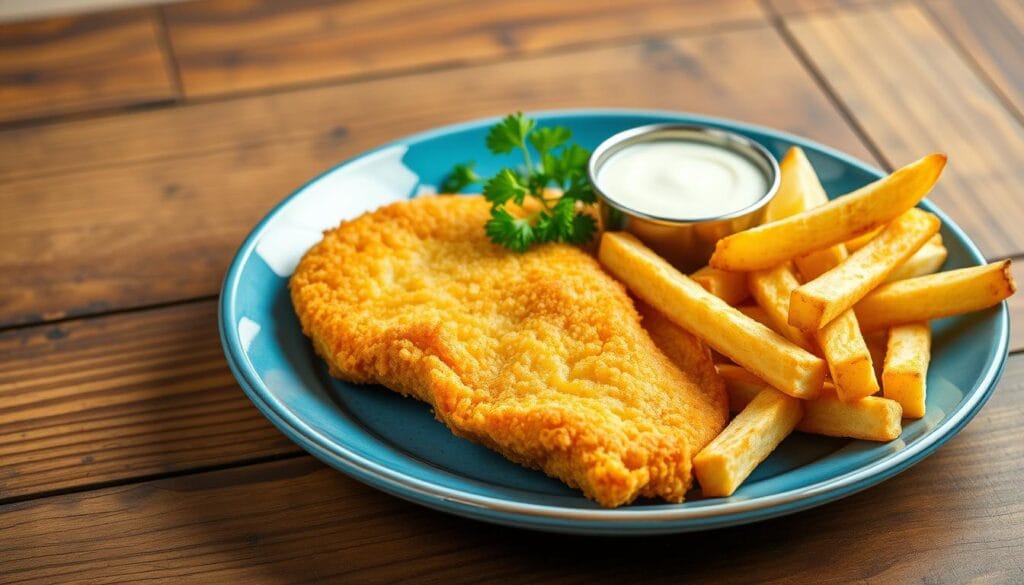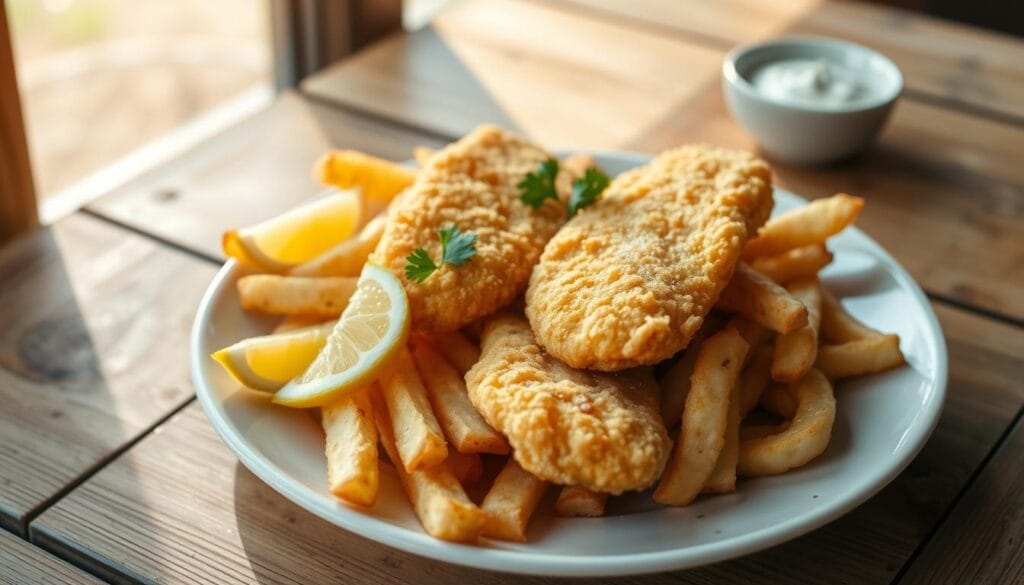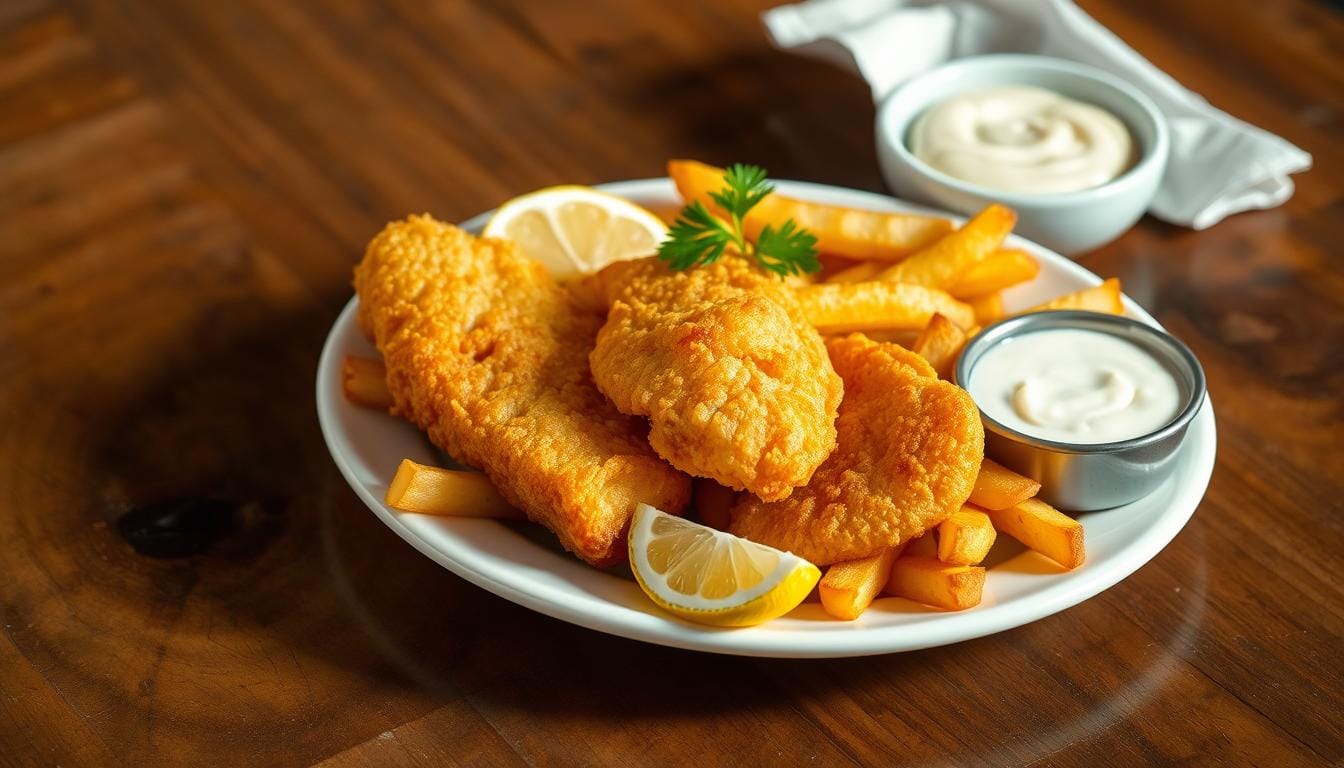Gluten-Free Fish and Chips: A Guilt-Free Treat
Imagine biting into a crispy, golden-brown piece of gluten-free fish and chips. It’s a delicious meal without the worry of gluten. Now, you can enjoy this classic comfort food, including gluten-free seafood, without worrying about your dietary needs.
For those with celiac disease or gluten sensitivity, traditional fish and chips can be tough. But, with the right ingredients and preparation, you can enjoy this beloved dish without guilt. In this article, we’ll show you how to make gluten-free fish and chips. We’ll cover selecting the right ingredients and achieving the perfect crunch.
Table of Contents
Understanding Gluten-Free Fish and Chips
For those with gluten intolerance or sensitivity, enjoying fish and chips can be tough. Traditional recipes often include gluten in the batter and sometimes in the chips. But, more restaurants now offer gluten-free options, making it easier to find a place that fits your needs.
Gluten-free dining is becoming more common. Brands like Pacific Seafood and Dr. Praeger’s offer gluten-free products. Restaurants like The Rage and Papa Chops also have 100% gluten-free fried fish, so you can enjoy this classic dish without gluten worries.
What Makes Traditional Fish and Chips Not Gluten-Free
Traditional fish and chips aren’t gluten-free because of gluten in the batter and sometimes in the chips. The batter usually has wheat flour, a big source of gluten. Also, gluten can get into the food during cooking, so it’s key to be careful when making gluten-free fish and chips.
The Rise of Gluten-Free Alternatives
Thanks to gluten-free alternatives, people with gluten issues can now enjoy fish and chips. Many places offer gluten-free options and use separate fryers to avoid cross-contamination. This growing demand means it’s easier to find a restaurant that meets your gluten-free needs.
Benefits of Going Gluten-Free
Choosing gluten-free can improve your digestion and boost your energy. Plus, gluten-free products are getting easier to find in stores and restaurants. When eating out, always ask about gluten-free choices and make sure the kitchen is careful to avoid cross-contamination.
| Restaurant | Gluten-Free Options |
|---|---|
| The Rage | 100% gluten-free fried fish |
| Papa Chops | 100% gluten-free fried fish |
| Republica | Gluten-free fish and chips upon request |
Essential Ingredients for Perfect Gluten-Free Batter
To make a delicious gluten-free fish fry, you need the right ingredients. Almond flour, sparkling water, and seasonings can be used to create a gluten-free batter. Look for brands like King Arthur Measure-for-Measure, which has less cornstarch for better results.
It’s important to use a blend without cornstarch in the top 3 ingredients for better batter consistency. Mixing rice flour with gluten-free flour can make the batter lighter and less dense. For frying, use canola, peanut, or vegetable oils. Fill the skillet about 2 inches deep.
Some key ingredients to keep in mind are:
- Gluten-free all-purpose flour
- Rice flour
- Almond flour
- Sparkling water
- Seasonings
When making a gluten-free fish fry, choose the right fish. Cod, haddock, pollock, flounder, halibut, or tilapia are all good options. Fresh fish will give you better texture than frozen and thawed fish.
By using the right ingredients and techniques, you can make a delicious gluten-free fish fry. It’s perfect for any occasion.
| Ingredient | Quantity |
|---|---|
| Gluten-free flour | 1 cup |
| Rice flour | 1/2 cup |
| Almond flour | 1/4 cup |
| Sparkling water | 1 cup |
Best Flour Alternatives for Crispy Coating
Choosing the right flour is key for a crispy coating on your fish. For those seeking gluten-free options, several alternatives can help. You can mix and match to find your favorite.
Rice flour offers a light texture, while chickpea flour adds a nutty taste and protein. Cornmeal provides a crunchy texture, especially when mixed with other gluten-free flours.
Almond flour and tapioca flour can also enhance your coating’s texture and taste. When eating out, ask about gluten-free dishes to avoid cross-contamination.
Rice Flour Options
Rice flour is a favorite for gluten-free cooking. It’s perfect for crispy coatings and delicate sauces. It’s a great choice for those with celiac disease.
Chickpea Flour Benefits
Chickpea flour, or gram flour, is packed with nutrients. It’s rich in protein and fiber, and a good source of iron and potassium. It’s a healthier option for many.
Cornmeal and Cornstarch Combinations
Cornmeal and cornstarch together make a crispy coating for fish and seafood. Mix them with spices and herbs for a tasty breading. This combo is a great gluten-free alternative.
Selecting the Right Fish for Your Dish
Choosing the right fish is key for tasty gluten-free fish and chips. You need a fish that stays firm and tastes great with gluten-free batter. Cod, haddock, and pollock are top picks because they’re firm and mild.
For a great gluten-free fish and chips recipe, pick a fish that’s not only tasty but also sustainable and fresh. Choose fish that’s certified as sustainably sourced and in season for the best taste and texture. Some top picks include:
- Cod: A classic choice for fish and chips, cod has a firm texture and mild flavor that works well with gluten-free batter.
- Haddock: Similar to cod, haddock has a slightly sweeter flavor and a firmer texture, making it a great option for gluten-free fish and chips.
- Pollock: A mild-flavored fish with a soft texture, pollock is a great choice for those looking for a lighter option.
Think about the flavor and texture you want when picking fish for your gluten-free dishes. Different fish might need different batters or cooking methods. With a bit of trial and error, you’ll find the perfect combination for delicious gluten-free fish and chips.
By picking the right fish and using gluten-free batter, you can make a dish that’s both tasty and safe for those with gluten issues. So, get creative with your gluten-free fish and chips recipe and enjoy finding the perfect fish for your dish.
| Fish Type | Flavor | Texture |
|---|---|---|
| Cod | Mild | Firm |
| Haddock | Slightly Sweet | Firm |
| Pollock | Mild | Soft |
Step-by-Step Guide to Making Gluten Free Fish and Chips
Making gluten-free fish and chips at home is easy. It’s a simple way to enjoy a gluten free dining experience. You can make a dish that’s both healthy and delicious.
Start by mixing gluten-free ingredients like rice flour, cornstarch, and spices for the batter. Let it rest for about 10 minutes. This lets the baking powder work its magic. Then, heat the oil in a deep pan to 350°F. This temperature gives you a crispy outside and a tender inside.
Here are some tips for achieving the perfect crunch:
- Use the freshest fish possible for the best flavor and texture.
- Choose the right type of fish, such as cod, haddock, or pollock, for a mild flavor and firm texture.
- Don’t overcook the fish, as it can become dry and tough.
For a gluten free dining experience that’s both tasty and healthy, try making gluten-free fish and chips at home. Follow these simple steps and tips. You’ll make a dish that everyone will love.
| Ingredient | Quantity |
|---|---|
| Rice flour | 1 cup |
| Cornstarch | 1/2 cup |
| Spices | 1 teaspoon |
By following these steps and using the right ingredients, you can enjoy a delicious and healthy gluten free dining experience. It’s perfect for any occasion.
Creating Gluten-Free Sides and Accompaniments
Enjoying gluten-free seafood is even better with the right sides and accompaniments. You can easily make gluten-free tartar sauce by swapping out regular mayonnaise and relish for gluten-free versions. For a tasty side, try gluten-free mushy peas made with frozen peas and a gluten-free broth.

For a crunchy touch, consider gluten-free onion rings or zucchini fries. Slice the onions or zucchinis, coat them in a gluten-free flour mix, and fry until golden.
Here are some tips for a complete gluten-free fish and chips experience:
- Use gluten-free condiments and seasonings to avoid cross-contamination
- Make your own gluten-free tartar sauce using gluten-free mayonnaise and relish
- Try using alternative gluten-free flours like rice flour or cornstarch to make crispy coatings
Follow these tips for a gluten-free seafood meal that’s perfect for any time. Whether it’s just for you or a big group, gluten-free seafood ensures everyone can enjoy without gluten worries.
Gluten-free eating doesn’t have to be boring or restrictive. With a little creativity and experimentation, you can create delicious and gluten-free meals that are perfect for any occasion.
Tips for Dining Out: Finding Celiac-Friendly Fish and Chips
Finding a best gluten free restaurant for fish and chips can be tough. About 1 in 133 Americans have Celiac disease. It’s key to avoid cross-contamination when eating out. Look for celiac-friendly restaurants that offer gluten-free options.
Start by searching for places with dedicated fryers and gluten-free menus. Some big chains, like those at Universal Orlando Resort, have special menus for guests with Celiac disease. For example, Bigfire at Universal CityWalk has a gluten-free menu and trained staff for safe dining.
Questions to Ask Your Server
- Do you have a dedicated gluten-free menu?
- Are your fryers separate from gluten-containing foods?
- Can you prepare my meal in a dedicated gluten-free area?
By asking these questions, you can find a best gluten free restaurant for tasty fish and chips. Always put your health first when eating out. Don’t be afraid to ask or get tips from celiac-friendly restaurants.
| Restaurant Chain | Gluten-Free Options | Cross-Contamination Precautions |
|---|---|---|
| Universal Orlando Resort | Gluten-free menu, dedicated fryers | Allergy-trained team members, separate preparation areas |
| Other chains | Varying gluten-free options | Varies by location, ask your server for details |
Common Mistakes to Avoid When Making Gluten-Free Batter
Making gluten-free fish and chips requires the right batter consistency. To get it just right, avoid common mistakes. Using the wrong flour can lead to a dense or soggy batter. Using a combination of gluten-free flours helps get the texture right.
Not drying the fish properly before battering is another mistake. This can make the batter soggy or fall off. To fix this, pat the fish dry with a paper towel before battering. Also, using the right oil for frying is key. Avocado oil or olive oil are good choices because they have a high smoke point, helping to create a crispy exterior.

- Apply the batter lightly to avoid a thick, heavy coating
- Avoid overmixing the batter to prevent a dense or tough texture
- Let the batter rest for at least 30 minutes to allow the flours to hydrate
By avoiding these mistakes and following these tips, you can make a delicious, crispy gluten-free fish fry. Always use fresh, high-quality ingredients for the best flavor and texture.
Health Benefits of Choosing Gluten-Free Options
Choosing gluten-free dining options can surprise you with many health benefits. If you have celiac disease or gluten sensitivity, a gluten-free diet can greatly improve your health. It can help with digestion, boost energy, and aid in weight management.
Some key benefits of gluten-free dining include:
- Improved digestive health, reducing symptoms like bloating and pain
- Increased energy levels, as your body absorbs nutrients better
- Weight management benefits, especially with healthy cooking methods
It’s important to remember that gluten-free doesn’t always mean healthier. Focus on whole, nutrient-rich foods like fruits, veggies, lean proteins, and whole grains. Choosing gluten-free options can lead to a healthier lifestyle.
Exploring gluten-free dining is more than just avoiding gluten. It’s about making choices that nourish your body. With the right approach, you can enjoy the benefits of gluten-free eating while keeping your diet balanced and satisfying.
Storage and Reheating Tips for Leftovers
Enjoying gluten free menu items like fish and chips requires the right storage and reheating. Cool leftovers to room temperature, then put them in an airtight container. Refrigerate for up to 3 days. To reheat, gently warm the fish in a microwave at 50% power. For the chips, reheat them in a 350°F oven for 5-10 minutes.
To keep the batter and chips crispy, try oven baking and air frying. Preheat your oven to 400°F. Bake the fish for 10-12 minutes until it’s 145°F inside. Air fry the chips at 400°F for about 10 minutes, shaking them halfway. This keeps your gluten free items crunchy.
For safely storing and reheating gluten free sides or sauces, use separate containers. Label each container with its contents and date. These tips help you enjoy gluten free fish and chips longer while keeping them tasty.
- Store leftovers in an airtight container and refrigerate for up to 3 days
- Reheat fish in a microwave at 50% power
- Crisp up chips by reheating them in a 350°F oven for 5-10 minutes
- Use a combination of oven baking and air frying to refresh crispiness
By using these storage and reheating methods, you can enjoy your gluten free menu items even as leftovers.
Conclusion: Enjoying Your Favorite Comfort Food Worry-Free
Gluten-free fish and chips can be just as tasty as the traditional kind. By trying out different gluten-free flours and improving your frying skills, you can enjoy this classic dish without worrying about gluten. Whether you’re eating out or cooking at home, finding gluten-free options has never been easier.
The secret to making great gluten-free fish and chips is finding the right mix of ingredients and mastering the cooking method. Try different fish types and batter recipes to find your favorite. With a bit of creativity and focus, you can enjoy this treat without feeling guilty and still get all the flavor and texture you love.
With more gluten-free dining options popping up, you can indulge in your favorite dishes while staying healthy. So, when you get a craving for fish and chips, go for it. Enjoy this delicious, gluten-free treat without any worries.
FAQ
What makes traditional fish and chips not gluten-free?
The batter for the fish and the breadcrumbs or flour for the chips usually have gluten. This comes from wheat flour.
What are the benefits of choosing gluten-free options for fish and chips?
Gluten-free fish and chips can help those with celiac disease or gluten sensitivity. It can also give more energy and help with weight management when cooked healthily.
What are the best gluten-free flour alternatives for creating a crispy coating?
Rice flour, chickpea flour, and mixes of cornmeal and cornstarch are top choices. They each bring something special to make the coating crispy.
What are some tips for dining out and finding celiac-friendly fish and chips?
Always ask your server about ingredients and how food is prepared. This helps avoid cross-contamination. Some restaurants are known for their gluten-free fish and chips.
How can you store and reheat leftover gluten-free fish and chips to maintain quality?
Cool leftovers properly and store them right. Reheat in the oven or air fryer to keep them crispy and tasty.
Source Links
- Keto Fish and Chips Recipe Gluten Free – https://www.castironketo.net/blog/keto-fish-and-chips/
- Gluten Free Fried Fish in Michigan – Recipes and Restaurants – https://miglutenfreegal.com/gluten-free-fried-fish-frozen-homemade-and-restaurant-options/
- How to Make Crispy and Delicious Gluten-Free Fried Fish in 20 Minutes – https://www.thespruceeats.com/gluten-free-fish-fry-recipe-1451039

